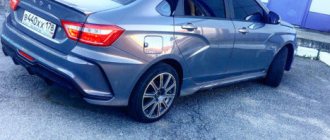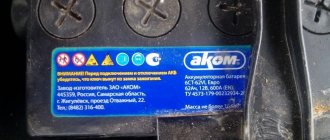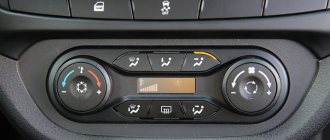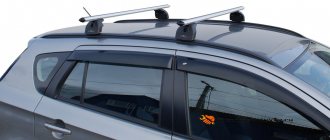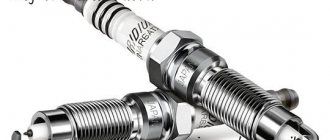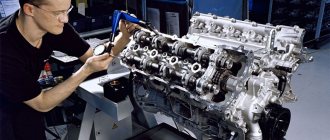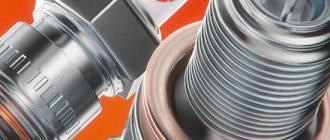What is the most important thing in a car? Wheels, interior, and maybe suspension - We believe that when choosing a car, everything is important. But the engine is the most important factor when deciding to buy a car. The Lada Vesta is powered by 3 modern engines from AvtoVAZ. Any car enthusiast would be curious to know in detail about each of them.
In total, the review material will consider three main types of engine:
— engine 21129 from VAZ — technical problems, characteristics; — 21179 from VAZ — the new top-end 1.8 engine is installed on the latest modifications, including the Lada Vesta SW Cross; The HR16DE-H4M propulsion system from Nissan is a chain motor with an impressive resource, but manual valve adjustment.
- What engine is installed on the Lada Vesta
- Motor VAZ 21129
- Motor VAZ 21179
- Engine Renault-Nissan H4M-HR16 DE
- Lada Vesta engine life - you need to know
- Subtle Features
What engine is installed on the Lada Vesta
The main engines for the Lada Vesta, which are installed by the manufacturer, are already indicated in the introduction. The company's decision to refuse to install the VAZ-11189 engine in the basic configuration was a winner. It seriously idles even on Grant and Priora; in fact, it is a modification of the VAZ-11186 model known to many. The only difference is that it has different intake and exhaust valves. The decision is due to the heavier body of the new car and increased requirements for the driving characteristics of the installed engine. There are three types of installations with different characteristics installed on cars. Two with a volume of 1.6 liters. and one 1.8 l. At 21179 AvtoVAZ had to increase engine power by 14 horses, without increasing appetite.
While writing this review, they traveled thousands of kilometers and we are ready to talk about the results. Recently, a wave of discussions was caused by the fact that one of the engines was not developed by VAZ, but will be supplied by Japanese manufacturers. Moreover, instead of the usual timing belt, it has a chain and it has more power. This allows you to seriously increase the power output of the motor. Is a chain better than a good engine belt?
Why does the break occur?
A broken timing belt or chain occurs for a number of reasons:
- defective or counterfeit belt/chain;
- poor maintenance, failure to meet replacement deadlines;
- Damage to the belt, chain or entire timing mechanism.
This can be avoided by timely servicing of the car at a dealer service station or in a proven service club (there is a risk of losing the warranty). A cheaper option would be to do it yourself.
Motor VAZ 21129
Let's talk about the first of two Russian models. There are quite a few differences between the 129 engine and the 127 Priorovsky, the youngest in the model range. In comparison with the VAZ-11186 engine, with a volume of 1.6 liters, it has a power of 106 horsepower. This difference is due to 16 valves instead of 8 in the previous version. Ambient temperature sensors and absolute pressure sensors are installed as standard. Characteristics of this Lada Vesta engine.
Power - 106 horsepower, spins up to 5800 rpm. Volume - 1.6 l. A highly modernized engine mount has been installed. Drive and timing type: standard DOHC timing belt. Torque characteristics - 148\4200. Motor weight - 109.2 kg. Cast iron cylinder block Electronic ignition system controlled by a processor. Adds dynamics to the car. Fuel type is unleaded gasoline with an octane rating of 95, but 92 is also possible. Power supply is via a distributed injection system. The car will accelerate to 100 km/h from 21129 in 12.8 seconds. With a 129 engine, Vesta consumes gasoline: in the city - 10.2 liters, mixed driving - 7.5 liters, on the highway - 6.2 liters.
Toxicity is at a level characteristic of the Euro 5 standard.
The running life is set at 200 thousand km.
Innovations compared to the design of the previous model monitor the quality of fuel, and do not idle. The damper system regulates the air supply at different speeds, which gives traction to the engine from the bottom and at the top.
Changes in the design of the 129 motor, facilitating long-term operation:
— a cylinder block with increased rigidity is installed, and other engine systems are improved. Compared to previous models, it shows an increase in quality indicators and meets European quality standards;
— the piston has one oil scraper ring and two thin compression rings, which reduces loss of performance due to friction;
— extensive opportunities for improving the power unit, tuning increases power to 145-150 hp.
The only noticeable drawbacks of the 129 engine are the high, uneven tone noise level. It may appear after prolonged use and at the very beginning. When the timing belt breaks, like most VAZ engines, it suffers from the fact that the valves bend.
Four Well-Known Facts
The service life of the timing chain always exceeds the service life of the engine. This is the first fact, but a condition must be met: the oil change must be timely. In general, the circuit fails gradually, and this is accompanied by symptoms:
- Audible sounds (chirping) at idle speed;
- When the “problem area” passes, a phase shift may be observed.
The last defect is detected using computer diagnostics.
From the appearance of any symptom to the complete rupture of the chain, a certain time passes. And in general, a “defective circuit” can work for a long time. This was another, fourth fact.
Source
Motor VAZ 21179
This engine option was the first in the line with a volume of 1.8 liters. produced since 2016. Externally similar to competitors, but inside there are a lot of design features characteristic of the 179 model. Vesta with a 1.8 liter engine installed 21179. is much more dynamic and powerful than his less productive colleagues.
Characteristics of 21179 engine:
Power - 122 horsepower, spins up to 6050 rpm. The most powerful of our line. Volume - 1.8 l. It is assembled using a selective conveyor method. Drive and timing type - a German device from INA is installed for tensioning a toothed belt. The belt will need to be replaced after about 90 thousand km. Torque characteristics - 170/3750. Motor weight - 110.1 kg. Higher than competitors, but the difference is not noticeable. Block material is cast iron. Electronic ignition system controlled by a processor. The fuel used is similar to the previous version, AI-95 gasoline. Using a 179 engine, the car will accelerate to 100 km/h in 12 seconds. Fuel consumption: in the city - 10 l, mixed type of movement - 8 l, on the highway - 7 l. Toxicity - Euro5. No different from others, despite significantly different parameters. The running life is set at 300 thousand km, which significantly exceeds that of the 129 model.
As advantages of the engine, we note the following: - The 179 engine is installed on the long-awaited Lada Vesta Cross by many car enthusiasts. The power and driving characteristics are enough to not have any problems driving; — fast and confident driving and start from traffic lights;
— design feature for changing gas distribution phases; — lightweight and enlarged intake (31 mm) and exhaust (28 mm) valves were used; — standard AMT VAZ transmission is used. Some of the components were not made in Russia, but were manufactured by leading automakers. For example, the valves are made by Mahle, and the oxygen sensor is made by Bosch.
The disadvantages of the engine are higher fuel and oil consumption compared to the other two power plants. Valve bending (like other options in the line), resulting in a high noise level when operating in any gear. The last circumstance is typical for engines installed in Lada Vesta.
Pistons that do not bend valves
Such pistons exist, but not for all cars. Sometimes the automaker modifies the pistons and installs plugless ones. Third-party companies make non-original components. But such pistons have 2 features:
- non-optimal shape of the piston bottom and, consequently, the combustion chamber, reduced compression ratio;
- they are heavier.
These factors reduce the efficiency of the motor by 5-10%.
After replacing the piston group with a non-standard one, mechanics modify the engine software to compensate for the change in the shape of the piston bottom. It may also be necessary to increase the thermal gap in the CPG.
Engine Renault-Nissan H4M-HR16 DE
This engine, produced by the joint company Renault and Nissan, is not equipped with a timing belt. A chain is installed instead. You can save quite a lot on consumables, their purchase and replacement. After all, a good belt complete with rollers costs from 4,500 rubles. Let's talk about the main characteristics of the unit:
Power - 114 horsepower. Volume - 1.6 liters, like the 21129 engine. Type of drive and timing - instead of a timing belt, as previously written, there is a chain. The only drawback is the moment, there are no hydraulic compensators in the design, which means approximately every 100 thousand km. mileage will require valve clearance monitoring. Like 2109 in 2018! Torque characteristics - 153/4400 Motor weight - 109.1 kg. Cylinder block material is aluminum. Electronic ignition system controlled by a processor. Fuel types - AI-92, AI-95, methane. There is more choice than others, although I doubt that our people only put 95 gasoline in 179 and 129, anything that burns is used!
Power supply using a distributed injection system. The car will accelerate to 100 km/h with the H4M-HR16 DE in 12.2 seconds. Gasoline consumption: in the city - 8.2 liters, mixed driving - 6.3 liters, on the highway - 5.4 liters. Toxicity is at the level of the Euro 5 standard. Running life is 250 thousand km.
It has the highest cost among the three units. An excellent choice for those who value power and comfort at the same time. By operating Vesta with a Nissan engine, we get high power and low fuel consumption. The solution for driving in the city and those who regularly make long trips. The durability indicator is also extremely high with adequate use and regular maintenance - running-in practice shows that its service life is much longer than that of VAZ competitors. However, with careful use, all three motors will show a longer service life and the engine will endure repairs. The disadvantages of the h4m-HR16 are the unusual nature of its timing component and high requirements for oil quality.
The compression ratio of the engine determines what kind of fuel is required for refueling. If the SG is less than 10, this means that AI92 gasoline is suitable. If the compression ratio is greater than 10, only give 95; on our units, only the H4M-HR16 DE came closest to 11.
- 21129 has a compression ratio of 10.5
- 21179 -10,3
- hr16de -10.7
How to prevent element damage?
Not many car enthusiasts agree to install modernized pistons for the reasons described above. Service station technicians strongly recommend that you carry out a technical inspection in a timely manner, as well as install high-quality and original parts.
Consequences of a broken timing belt
Lada Vesta engine life - you need to know
Life tests of the units installed on Vesta allow us to say that the overall impression of them is rather good.
We have already mentioned what resource the factory installs in the description of each motor; here we will briefly write:
— VAZ 21129 resource — 200,000 km; — motor life of the VAZ 21179 engine is 300,000 km; — resource hr16de from Nissan — 250,000 km.
Tuning is available in a wide variety of designs. Excellent options for tuning measures to improve driving characteristics would be the installation of a lightweight crankshaft and forward air flow. You can install an additional turbine; after modification, you need to improve not only the engine, but also other components of the car.
The main malfunctions and ways to eliminate them are:
1. An unpleasant whistle under the hood - most likely the timing belt has stretched and is close to breaking. It is better to replace if possible;
1.1 Unpleasant bubbling noise under the hood - the hr16de chain may have stretched and requires attention; 2. The engine stalls regularly for no apparent reason - a likely scenario is that the relay in the ignition unit has failed. It can be repaired during a recall campaign for defective vehicles; 3. At medium speeds, a characteristic nasty sound occurs - the gasket in the exhaust pipe has burned out or is burning out. Replacement is easy, especially if you contact the ASC; 4. The appearance of such a phenomenon as vibration - in VAZ engines this is a design flaw associated with the right airbag. Replace and the problems will disappear.
5. Increased fuel consumption, unstable operation, sluggish acceleration from more than 15 to hundreds - the oxygen concentration sensor (lambda probe) may be broken.
Lada Vesta Angkor multimedia › Logbook › timing drive LADA VESTA
Full size patient ready Hello everyone! So the mileage is already 34 thousand kilometers, the sound of whistling when hot has appeared with a frequency of 1 time per second! I looked at the Priora forums and decided to do maintenance on the rollers, I’ll say right away that maybe someone doesn’t know, the timing belt and rollers with a pump easily fit from the Priora (126 engine). what you will need: 1. a jack 2. a garage with a pit 3. a wrench for tensioning the belt Procedure: 1. remove the engine protection (if any) 2. place a beam across the pit 3. jack it up by the pallet in front of the engine 4. slightly lift the engine 5. unscrew 2 screws with an E12 head for the engine mount (unscrewed it with a 10 head) 6. unscrew 2 bolts with a 16 head 7. pull out the engine mount 8. raise the engine a little higher (in order to more conveniently unscrew the casing bolts) 9. unscrew the casing screws, there are 5 of them under the hexagon 5 10. pull out the casing 11. bring the camshaft pulleys to the marks on the rear wall of the casing 12. unscrew the support roller and tensioner, then I removed the bearing cage and saw that there was practically no lubricant from the factory at all, and besides, it was not of very good quality , belt and rollers from GETS, I cleaned it all in kerosene, pushed new grease for the bearings into it, and put everything back together.
Full size, as you can see from the mark, the belt has been re-tightened from the factory!
Full size, this is what my version of the timing belt repair on the West looks like)
Full Size Plastic Roller Gets
Full sizing roller, zero lubrication
Full size tension roller, also not thick
Full size, for comparison, this is already a clean support roller. THE RESULT does not whistle at all, and even the whistling that was always there has also disappeared! Now the videos are quietly moving for another 60 thousand! and then the pump needs to be changed.
Even 3 years ago, rumors began to spread across the Internet about the development of a new 1.8 liter engine at AvtoVAZ. The motor was intended for some new product that was kept secret. Now we already know that this development is the 1.8 Lada Vesta Cross engine. Before this, there had already been attempts to develop a 1.8 engine, which was later successfully assembled by Lada’s subsidiary Super-Auto. This engine had the index 21128 and was even installed on the Lada Priora Sport for some time. But as time has shown, the motor turned out to be unreliable and had a short resource. After which AvtoVAZ gathered its strength again and released a new 1.8 Lada Vesta SV Cross engine, in which all the shortcomings of the 21128 engine were eliminated.
